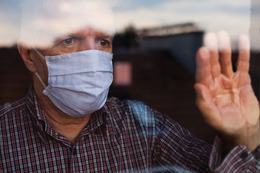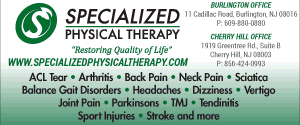
In the latter half of April 2022, New Jersey reported that at least 9,474 of its then-30,345 confirmed COVID-19 fatalities have been among the residents and staff members at nursing homes and other long-term care facilities.
But industry advocates and employees insist that those numbers don’t tell the full story of a field that has been monitored, maligned and misunderstood more throughout the pandemic. It is, they say, largely due to an early perception that such facilities must be inept, heartless or irresponsibly unprepared for a worldwide health emergency that caught everyone off-guard and was plagued by uncertainty in its earliest days—when the majority of those nursing-home COVID deaths actually occurred.
While there were pockets of infection and exposure throughout the United States as early as January 2020, New Jersey was among the first 15 states to confirm a COVID case and one of the hardest-hit early on.
“There was so much unknown at that time: People forget that we had no idea what we were dealing with at that time, because they look at it through the lens of what we know now,” says Andy Aronson, president and CEO of the Health Care Association of New Jersey, which represents and advocates for the state’s long-term care facilities. “The peak of COVID in New Jersey was the beginning of April of 2020; guidance did not even come from the CDC as far as nursing homes were concerned until after New Jersey had hit its peak … There was no guidance on how to deal with it, there was no understanding, we didn’t have the basic tools then that we have now, so there was no testing, there were no vaccines, no treatments.”
“What made it really tricky was just the whole idea that somebody can be asymptomatic but still be contagious,” adds Linda Schwimmer, president and CEO of the New Jersey Heath Care Quality Institute (NJHCQI). “It just made for a very scary atmosphere for everybody in these buildings.”
Nobody was prepared for a brand-new virus. And with protective personal equipment and other safety measures understandably being prioritized for the hospitals handling the most COVID cases, nursing homes were neither ready nor equipped for the chaos of the pandemic’s immediate aftermath, starting from the already disadvantageous position of being chronically understaffed before the pandemic, and overworked as soon as it began.
“That initial hit of COVID in the spring and summer 2020, when COVID hit the New Jersey/New York area first and hardest, the workers were stretched to their limits,” Aronson says. “They were dealing with something that was completely unknown, they were worried about their residents, they were worried about themselves, they were worried about their families and what they were bringing home. It was emotionally a very, very difficult time and those workers who did work through it deserve so much credit—there’s not enough good things we can say about them. They were seeing stories on the news every day about people dying, they were probably seeing people die in their facilities, either residents or other staff members.”
The daily horrors and heartbreak staff witnessed in private were soon eclipsed by far more public ones, as distraught families saying their last goodbyes over iPads became more vocal in their frustration over being denied in-person visits with or ability to provide comfort to dying loved ones for fear of infection. With more specific grievances accruing—perhaps most egregiously, the April 2020 discovery that a North Jersey nursing center with numerous state inspector checkmarks against it had stacked the bodies of 17 patients in a tiny makeshift morgue, unbeknownst to their loved ones—the entire industry’s reputation has been tarnished.
But those who work in the field say it’s both an unfair mass generalization and indicative of how much needs to improve to deliver better care in the future, in both unprecedented and ordinary times.
Early Struggles
As Aronson points out, it is easy to retroactively color the entire pandemic in the knowledge we’ve gained throughout its progression, but those first few months were untested waters plagued by unknowns. It’s equally tempting to regard Gov. Phil Murphy’s decision to allow COVID-positive patients admission into nursing facilities as anything other than having to legislate in times of crisis.
“That became a bit of a political issue and there was criticism but I’m not really sure where the critics thought these patients should go,” says Schwimmer. “The hospitals needed to be opened up for people who needed ventilators and ICUs—they were already putting ICUs into conference rooms in hospitals. They didn’t have the ability to keep all of these patients who were stabilized–they might still be contagious but they were stabilized—they had to move them someplace. And the nursing homes were the logical place to move them, and to cohort them in a whole COVID unit.”
With that rapid uptick in patient intake, increased medical demands and adapting to the reality that every day was going to be stressful in entirely new ways, workers were left doing whatever it took to get through another unpredictable day.
“It was trial by fire: Let’s figure out how to get through today and then we’ll figure out tomorrow,” Aronson explains.
They were struggling to do more with less even before the pandemic. By their nature, long-term care facilities don’t pay well, especially in New Jersey. It is the only state, Aronson points out, that pays those employees with a flat-rate system rather than including incentives within the Medicaid payment model “that allows providers to receive more money, or receive a portion of their payment, for doing things the right way.”
Those facilities’ health care providers often have to take on a second job to make ends meet, further increasing their exposure risk potential.
“Because these nurses’ day jobs are low-pay jobs, a lot of people work at multiple, different places, so they were going from place to place, which, from an infectious standpoint, is probably the worst thing you could do, but it’s what they had to do to survive,” Schwimmer says.
Jim Clancy, executive director at the United Methodist Communities (UMC), notes that community support, constant communication, a tirelessly devoted staff and a parent organization that “provided extra compensation to the staff and has done so many things to help” allowed UMC’s Collingswood location to weather the storm better than many others, but it was still an uphill battle to get there, marked by an ever-hastening rate of employee attrition.
“I really praise my team and, fortunately, we work for a very solid organization that’s been very supportive but I feel like we’ve survived a war,” he admits. “I’ve been a nursing home administrator for 27 years and I’ve worked in the business for 40, and I can tell you that I’ve never worked harder in my life. I’m quite certain that we’ve lost a few good people who’ve rethought what they want to do as a career because it’s been so difficult to function in this environment.”
Among the tenets of long-term facilities is the inevitability of handling end-of-life care, helping people put their affairs in order, and making sure that next of kin are adequately educated about a loved one’s wishes. These difficult conversations have historically been made a little easier by at least having standards of practice in place and enough time and staff to ensure a gentle approach—a gesture of humanity that the nature of emergency circumstances denied many.
“A lot of people don’t have all those documents filled out when they enter a nursing home, and it really became a problem during the pandemic,” notes Schwimmer. “Getting in touch with family members to have all the documentation filled out, it had to be done by phone, and it was a really hard conversation to have in a crisis situation, as opposed to having more personalized, multiple conversations when you’re not already in a crisis state.”
The Emotional Toll
“I don’t think you can underestimate the level of stress they’ve been under—the residents, the families, as well as the staff, the owners, up and down the line,” she continues.
Those who gravitate to the elder-care field have to learn how to grapple with death: Aronson notes that, as hard as it is to frankly discuss, “nursing homes are here to provide end-of-life care.” But Clancy recalls a UMC nursing supervisor who exemplifies just how much more loss workers were expected to absorb, as that supervisor’s job essentially became “holding the iPad up so a family could say goodbye because we weren’t allowed to have family come into the building.”
He adds, “I would come in on a Saturday or Sunday and just see families lined up at the windows of their loved ones, since the only way they could visit was through the window. It was a really difficult experience.”
While it feels coldly dismissive to regard any of COVID’s lessons as silver linings, it has at least underscored how much more support nursing facilities’ staff need to do their jobs well without sacrificing their mental and physical wellness so much that it leads to burnout.
NJHCQI, for example, has worked closely with Project ECHO, a nonprofit virtual learning collaborative that originated with the University of New Mexico that the Centers for Medicare & Medicaid Services rolled out for nursing homes across the country to connect those on to connect with their neighboring peers, ask questions, find empathetic support, receive advice for implementing new regulations, get health officials’ ears, and “discuss any particular challenges or clarify anything confusing.”
“It met multiple times a week for something like 20 weeks, and those intensive sessions enabled them to really have the sounding board they needed, and also have a dialogue with the Department of Health—that direct conduit to the Department of Health let them ask those nitty-gritty questions they needed someone to answer,” Schwimmer says.
Tarnished Reputations
Those alarming reports and staggering death tolls coming from nursing homes in the pandemic’s earliest days made countless grieving family and friends feel like they lost someone too soon, or that a loved one died needlessly alone. Knowing that nothing will bring them back or offer a second chance at a last farewell had emotions running high; long-term care facilities’ disproportionately high numbers of loss made them easy targets for that inconsolable grief.
“COVID really shined a light on nursing homes in a negative way, which, as an industry advocate, is incredibly unfair,” says Aronson. “What these facilities and their workers did to take care of people during the pandemic is absolutely heroic, but the focus was on how many people are dying—which, in my view, was the fault of the virus. … All of the data out there shows that COVID affects the frail, the elderly and the people with compromised immune systems much more directly than it affects others.”
Reports of frightening conditions and both state and federal investigations into nursing facilities receiving Medicaid dollars led to the New Jersey comptroller’s office rating 15 of those facilities across the state, including six in South Jersey, as one-star locations (based on inspections, quality measures and staffing) for at least six of the past eight quarter-years. They will need to improve their conditions or face a shutdown.
But it is a well-intentioned metric being utilized incorrectly, Aronson says.
“The five-star rating system, in general, was a system developed to be a tool for consumers, which they should absolutely use—but it was never designed as a be-all, end-all system to measure the quality of a nursing home, it’s not an appropriate tool for that,” he explains. “The way the survey program is set up by the federal government, the lowest 20% of the facilities in every state are deemed to be one-star in the survey. If New Jersey had the 350 best nursing homes in the United States, 20% of them would be rated one-star because the system requires it.”
What Comes Next
“The way in which the United States finances, delivers, and regulates care in nursing home settings is ineffective, inefficient, fragmented, and unsustainable … We must stop viewing nursing home residents as ‘them’—they are our grandparents, parents, friends, siblings, and veterans,” noted Betty Ferrell, director of nursing research and education and professor at City of Hope Medical Center, when the committee she chaired announced “The National Imperative to Improve Nursing Home Quality,” a report the National Academies of Sciences, Engineering, and Medicine released earlier this month. Among its calls to action is detailing how transforming the way nursing home care is delivered, financed and regulated means the dignified care those patients deserve.
That total transformation, local experts say, requires improved “investment in the workplace,” including better pay, better support and better benefits.
“The stories [people] tell about going through the COVID surges are heartbreaking,” says Aronson. “We’ve seen just how difficult that job can be and that the people who do this need to be paid wages that are appropriate, and they need to be appreciated. Maybe we took them for granted going into the pandemic. Reforms need to be put in place to really recognize our health care workers, really encourage people to get into that field and respect those workers—starting with the pay they deserve.”
“We have so many studies showing that having higher staffing ratios leads to better care,” Schwimmer adds, noting that the Department of Health needs “a more robust staff, too … At a certain point, you’re not working smarter anymore—you’re just overworked.”
Beyond bolstering staff to realistically tenable numbers, the facilities’ very infrastructure and the ways they received guidance need to change, too, starting with some kind of education aligned with the emergency at hand.
“These nursing homes, a lot of the work was put on local public health officers was to interface with them, but very many of those local public health officers have training in infectious disease—some of them do, and some have the benefit of having partners or local residents or medical practices that could pitch in, but that’s just by chance,” Schwimmer says. “We really need to have infectious disease experts officially working with every single nursing home in the state in a way that’s audited and checked—and we saw the benefit of that, because there was an infectious disease expert on every Project ECHO call sharing critical information that was new to a lot of people.”
After all, with long-term care facilities often being the last place many of our loved ones—or even ourselves—will call home, it’s crucial that they’re able to deliver the comfort everyone has a right to in their twilight years, no matter the state of the world.
“I’m very proud to advocate for these facilities, which are absolutely essential to our health care system,” Aronson says. “Senior citizens cannot have the health SJcare system they deserve without quality nursing homes, and we all really need to work together to make sure these facilities are as good as they can be.”
Click here to subscribe to the free digital editions of South Jersey Magazine
To read the digital edition of South Jersey Magazine, click here.
Published and copyrighted in South Jersey Magazine, Volume 19, Issue 11 (April2022)
For more info on South Jersey Magazine, click here.
To subscribe to South Jersey Magazine, click here.
To advertise in South Jersey Magazine, click here.











